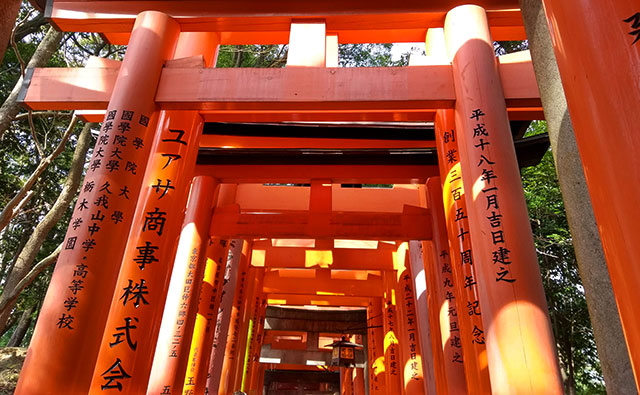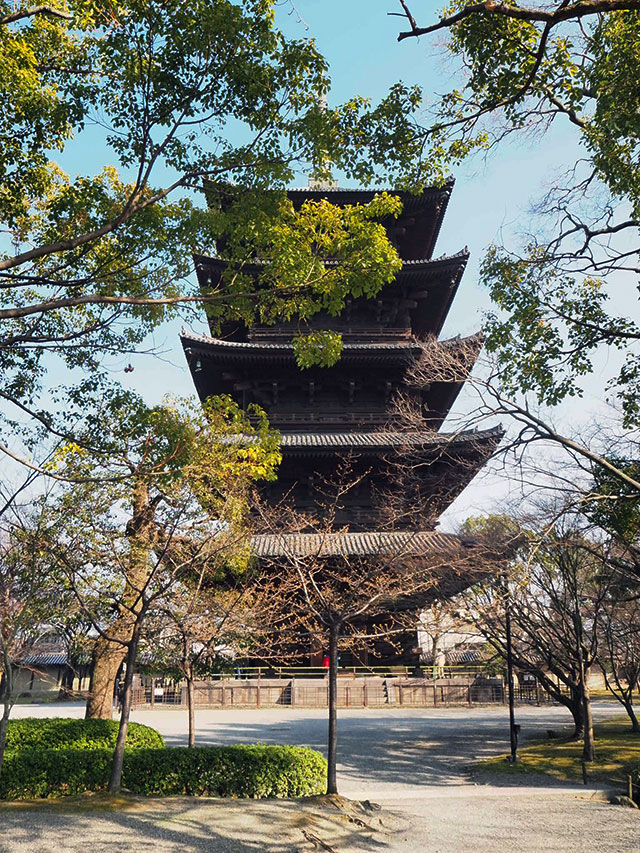The traditional, atmospheric Kyoto used to be the capital of Japan, and is still one of the biggest cities in the country. Tourists flock to Kyoto to experience a traditional, old-school Japan complete with beautiful gardens, imperial palaces, Buddhist temples and Shinto shrines. We walked most of the way around the city, but did hop onto a metro train at one point to maximise our time as we were only there for one day. We managed to see quite a few different shrines and temples, but the ones featured in this post were our highlights and memories that we’ll hold onto forever. It really is such a beautiful and inspiring place to visit if you’re planning a trip to Japan.
Fushimi Inari Taisha
Fully equipped with hot cans of coffee from the station vending machines, we used our Japan Rail passes to book tickets onto the Tokaido Shinkansen line direct to Kyoto, which only took about 3 hours each way. It was amazing to experience comfortable, organised, super-fast travel with the bonus of an unexpected view of Fuji as we made our way across the country.
As soon as we arrived (after a hearty McDonald’s breakfast, no, we have no shame) we headed north of the station, having no real plans for the day other than wandering around and seeing where our stroll would take us. We ended up discovering some beautiful gardens belonging to Kennin-ji, an historical Buddhist temple that completely took our breath away. After spending a good ten minutes taking photos of the outside, a guard came up to us to put out that if we ducked our heads under the awning, we could see inside and discover an ancient ink painting of two giant dragons covering the ceiling. Very cool.
We then headed to one of the most recognised shrine’s in Japan; Fushimi Inari Taisha. We saw maybe five people on our walk there but once we approached the base of the shrine, we suddenly encountered hundreds of visitors, some dressed in traditional Japanese outfits. The shrine sits at the base of a mountain and includes trails through the surrounding forest to many smaller shrines which take approximately 2 hours to walk up (top tip: so wear comfortable shoes and take water with you.) There is no escaping how awe-inspiring the shrine is. It has a distinct bright orange colour and is surrounded by fox statues which were fun to spot on our walk (we discovered that they are identified with the messenger of Inari, the rice god.) At the base, there are plenty of souvenir stalls and even a food market.

Toji Temple
After a quick metro trip back to where we started our journey, we stopped for a well-deserved katsu curry lunch (at our new favourite chain restaurant, Coco Ichibanya ) before a short walk to Toji Temple, near Kyoto station. Built in 796, soon after Kyoto’s founding, It is the only remaining of the three temples that were allowed to be built in Kyoto at that time. Now temples are everywhere in Kyoto, but this was our favourite. With it’s five-storied pagoda it is the highest in Japan and sits within a quiet, reflective garden where you can take a moment from your crazy day sightseeing to breathe it all in and watching the Koi Carp swimming about in the pond.

Nishiki food market
For us, that was a great way to finish our tour of the temples but we still had one more place on our hit list; Nishiki food market. A colourful, traditional food market, it is packed with vendors offering fresh seafood, vegetables and dishes from soups to curries. We picked up some fried vegetable snacks and ended our trip in a nearby cafe for hot chocolate. A fitting end to a busy day.
Lauren Loves
Kyoto is a wonderful city, full of history and steeped in tradition: so different from the bustling Tokyo! I really was spellbound by Toji Temple; it’s size and splendor spoke of another time. I would definitely recommend walking as much as possible as by doing that we came across numerous shrines and Buddhist temples that we hadn’t planned on visiting but each had it’s own particular charm. It was also educational; we didn’t really know much about Shinto religious beliefs and the difference between shrines or temples before we visited. I would love to come back and experience a traditional tea service, maybe in spring to see the place surrounded by cherry blossoms.
Robert Loves
The train journey is quick enough to be done as a day trip, but we realised quickly that we wouldn’t get the full experience in a day. Luckily we made the best of it and explored and saw as much as we could. The food market had a selection of all sorts of weird and wonderful foods that Japan has to offer and we were brave enough sample a couple of things. Just when our feet could walk no more it was time to catch our train back to Tokyo, a day well spent.